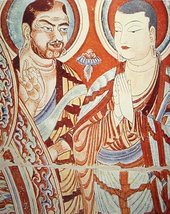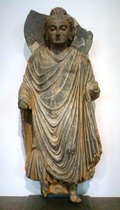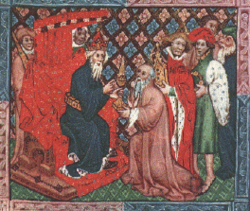Silk Road
|
|
The Silk Road was an interconnected series of routes through Southern Asia traversed by caravan and ocean vessel, and connecting Chang'an, China with Antioch, Syria, as well as other points. Its influence carries over on to Korea and terminated eventually in Japan. Silk road is a translation from the German Seidenstraߥ, the term first used by German geographer Ferdinand von Richthofen in the 19th century.
The continental Silk Road diverges into North and South routes as it extends from the commercial centers of North China, the North route passing through the Bulgar-Kypchak zone to Eastern Europe and the Crimean peninsula, and from there across the Black Sea, Marmara Sea and the Balkans to Venice; the South Route passing through Turkestan-Khorasan, through Iran into Mesopotamia and Anatolia, and then through Antioch in Southern Anatolia into the Mediterranean Sea or through the Levant into Egypt and North Africa.
These exchanges were critical not only for the development and flowering of the great civilizations of Rome, China and India, but they laid the foundations of our modern world. While goods and religious ideas may have travelled the whole way, ancient trade was probably conducted over sections of the routes and it is probable that merchants and travellers very rarely, if ever, covered the whole distance between Europe, or the Middle East, and China, by land.
The last missing railroad link on the Silk Road was completed in 1992, when the international railway communication Almaty - Urumqi opened.
| Contents |
Origins
Cross-continental travel
As domestication of efficient pack animals increased the capacity for prehistoric peoples to carry heavier loads over greater distances, trade and cultural exchanges among widely separated populations developed rapidly. For example, the dromedary may have been domesticated as early as circa 1100 BC, and the nomads of the vast Eurasian steppe-lands had domesticated horses around 4000 BC. Domestication of the Bactrian camel followed later.
Grasslands stretch like a long ribbon between the desert and the main agricultural and urban regions all the way from the shores of the Pacific to Africa, and deep into the heart of Europe. These grasslands were sufficiently fertile to provide grazing, water, and fuel for caravans to pass through while avoiding trespassing on agricultural lands. This presented ideal conditions for merchants, mounted warriors and caravans to travel immense distances without arousing the hostility of more settled peoples.
Original routes
Routes along the Persian Royal Road (constructed 5th century BC) may have been in use as early as 3500 BC. There is evidence that Ancient Egyptian explorers may have originally cleared and protected some branches of the Silk Road.
Lapis lazuli was being traded from its only known source in the ancient world – Badakshan, in what is now northeastern Afghanistan – as far as Mesopotamia and Egypt by the second half of the 4th millennium BC. By the third millennium BC lapis lazuli trade was extended to Harappa and Mohenjo-daro in the Indus valley.
The ancient harbor constructed in Lothal, India, may be the oldest sea-faring harbor known.
Egyptian maritime trade
In one scene in the pyramid of Pharaoh Sahure of the Fifth Dynasty, Egyptians are returning with huge cedar trees. Sahure's name is found stamped on a thin piece of gold on a Lebanon chair, and 5th dynasty cartouches were found in Lebanon stone vessels. Other scenes in his temple depict Syrian bears. The Palermo Stone also mentions expeditions to Sinai as well as to the diorite quarries northwest of Abu Simbel.
The oldest known expedition to the Land of Punt was organized by Sahure, which apparently yielded a quantity of myrrh, along with malachite and electrum. The 12th-Dynasty Pharaoh Senusret III had a "Suez" canal constructed linking the Nile River with the Red Sea for direct trade with Punt. Around 1950 BCE, in the reign of Mentuhotep III, an officer named Hennu made one or more voyages to Punt. A very famous expedition was conducted by Nehsi for Queen Hatshepsut in the 15th century BCE to obtain myrrh; a report of that voyage survives on a relief in Hatshepsut's funerary temple at Deir el-Bahri. Several of her successors, including Thutmoses III, also organized expeditions to Punt.
Chinese Trade
From the 2nd millennium BC nephrite jade was being traded from mines in the region of Yarkand and Khotan to China. Significantly, these mines were not very far from the lapis lazuli and spinel ("Balas Ruby") mines in Badakhshan and, although separated by the formidable Pamir mountains, routes across them were, apparently, in use from very early times.
The Tarim mummies, Chinese mummies of an Indo-European type, have been found in the Tarim Basin, such as in the area of Loulan located along the Silk Road 200 kilometers east of Yingpan, dating to as early as 1600 BC and suggesting very ancient contacts between East and West. It has been suggested that these mummified remains may have been the work of the ancestors of the Tocharians whose Indo-European language remained in use in the Tarim Basin (modern day Xinjiang) of China until the 8th century CE.
Some remnants of what was probably Chinese silk have been found in Ancient Egypt from 1070 BC. Though the originating source seems sufficiently reliable, silk unfortunately degrades very rapidly and we cannot double-check for accuracy whether it was actually cultivated silk (which would almost certainly have come from China) that was discovered or a type of "wild silk," which might have come from the Mediterranean region or the Middle East.
Persian Royal Road
By the time of Herodotus (c. 475 BC) the Persian Royal Road ran some 2,857 km from the city of Susa on the lower Tigris to the port of Smyrna (modern Izmir in Turkey) on the Aegean Sea. It was maintained and protected by the Achaemenid empire (c.700-330 BC) and had postal stations and relays at regular intervals. By having fresh horses and riders ready at each relay, royal couriers could carry messages the entire distance in 9 days, though normal travellers took about three months. This Royal Road linked into many other routes. Some of these, such as the routes to India and Central Asia, were also protected by the Achaemenids, encouraging regular contact between India, Mesopotamia and the Mediterranean. There are accounts in Esther of dispatches being sent from Susa to provinces as far out as India and Cush during the reign of Xerxes (485-465 BC).
Hellenistic conquests
EuthydemusI.jpg
UrumqiWarrior.JPG
When Alexander the Great's successors, the Ptolemies, took control of Egypt in 323 BC, they began to actively promote trade with Mesopotamia, India, and East Africa through their ports on the Red Sea coast, as well as overland. This was assisted by the active participation of a number of intermediaries, especially the Nabataeans and other Arabs. The Greeks were to remain in Central Asia for the next three centuries, first through the administration of the Seleucid Empire, and then with the establishement of the Greco-Bactrian Kingdom in Bactria. They kept expanding eastward, especially during the reign of Euthydemus (230-200 BC), who extended his control to Sogdiana, reaching and going beyond the city of Alexandria Eschate. There are indications that he may have led expeditions as far as Kashgar in Chinese Turkestan, leading to the first known contacts between China and the West around 200 BC. The Greek historian Strabo writes that "they extended their empire even as far as the Seres (China) and the Phryni" (Strabo XI.XI.I (http://www.perseus.tufts.edu/cgi-bin/ptext?lookup=Strab.+11.11.1)).
Chinese exploration of Central Asia
ZhangQianTravels.jpg
HanHorse.JPG
The "Silk Road" essentially came into being from the 1st century BC, following these efforts by China to consolidate a road to the Western world and India, both through direct settlements in the area of the Tarim Basin and diplomatic relations with the countries of the Dayuan, Parthians and Bactrians further west.
A maritime "Silk Route" opened up between Chinese-controlled Jiaozhi (centred in modern Vietnam [see map above], near Hanoi) probably by the first century CE. It extended, via ports on the coasts of India and Sri Lanka, all the way to Roman-controlled ports in Egypt and the Nabataean territories on the northeastern coast of the Red Sea.
The Roman historian Florus also describes the visit of numerous envoys, included Seres (Chinese), to the first Roman Emperor Augustus, who reigned between 27 BCE and 14 CE:
- "Even the rest of the nations of the world which were not subject to the imperial sway were sensible of its grandeur, and looked with reverence to the Roman people, the great conqueror of nations. Thus even Scythians and Sarmatians sent envoys to seek the friendship of Rome. Nay, the Seres came likewise, and the Indians who dwelt beneath the vertical sun, bringing presents of precious stones and pearls and elephants, but thinking all of less moment than the vastness of the journey which they had undertaken, and which they said had occupied four years. In truth it needed but to look at their complexion to see that they were people of another world than ours." ("Cathey and the way thither", Henry Yule).
The Roman Empire and silk
Menade.JPG
The Senate issued, in vain, several edicts to prohibit the wearing of silk, on economic and moral grounds: the importation of Chinese silk caused a huge outflow of gold, and silk clothes were considered to be decadent and immoral: "I can see clothes of silk, if materials that do not hide the body, nor even one's decency, can be called clothes... Wretched flocks of maids labour so that the adulteress may be visible through her thin dress, so that her husband has no more acquaintance than any outsider or foreigner with his wife's body" (Seneca the Younger (c. 3 BC–AD 65, Declamations Vol. I).
The Hou Hanshu records that the first Roman envoy arrived in China by this maritime route in 166 CE, initiating a series of Roman embassies to China.
Central Asian commercial & cultural exchanges
BegramGladiator.JPG

Westerner_on_a_camel.JPG
The Kushan empire, in the northwestern part of the Indian subcontinent, was located at the center of these exchanges. They fostered multi-cultural interaction as indicated by their 2nd century treasure hoards filled with products from the Greco-Roman world, China and India, such as in the archeological site of Begram.
The heyday of the Silk Road corresponds to that of the Byzantine Empire in its west end, Sasanid Period to Il Khanate Period in the Nile-Oxus section and Three Kingdoms to Yuan Dynasty in the Sinitic zone in its east end. Trade between East and West also developed on the sea, between Alexandria in Egypt and Guangzhou in China, fostering the expansion of Roman trading posts in India. Historians also talk of a "Porcelain Route" or "Silk Route" across the Indian Ocean. The Silk Road represents an early phenomenon of political and cultural integration due to inter-regional trade. In its heyday, the Silk Road sustained an international culture that strung together groups as diverse as the Magyars, Armenians, and Chinese.ForeignMerchant.jpg
The Silk Road gave rise to the clusters of military states of nomadic origins in North China, invited the Nestorian, Manichaean, Buddhist, and later Islamic religions into Central Asia and China, created the influential Khazar Federation and at the end of its glory, brought about the largest continental empire ever: the Mongol Empire, with its political centers strung along the Silk Road (Beijing in North China, Karakorum in central Mongolia, Sarmakhand in Transoxiana, Tabriz in Northern Iran, Astrakhan in lower Volga, Bahcesaray in Crimea, Kazan in Central Russia, Erzurum in eastern Anatolia), realizing the political unification of zones previously loosely and intermittently connected by material and cultural goods.
The Roman empire, and its demand for sophisticated Asian products, crumbled in the West around the 5th century. In Central Asia, Islam expanded from the 7th century onward, bringing a stop to Chinese westward expansion at the Battle of Talas in 751 CE. Further expansion of the Islamic Turks in Central Asia from the 10th century finished disrupting trade in that part of the world, and Buddhism almost disappeared.
See also: Silk Road transmission of Buddhism
Mongol era
- See main article, Mongol Empire: Silk Road.
The Mongol expansion throughout the Asian continent from around 1215 to 1360 helped bring political stability and re-establish the Silk Road (vis-୶is Karakorum). With rare exceptions such as Marco Polo or Christian ambassadors such as William of Rubruck, few people traveled down the entire length of the silk road. Instead traders moved products much like a bucket brigade, with luxury goods being traded from one middleman to another, from China to the West, and resulting with extravagant prices for the trade goods.
However, the disintegration of the Mongol Empire did not see the continuation of Silk Road's political unity. Also falling victim were the cultural and economic aspects of its unity. Turkmeni marching lords seized the western end of the Silk Road, i.e. the decaying Byzantine Empire. After the Mongol Empire, the great political powers along the Silk Road became economically and culturally separated. Accompanying the crystallization of regional states was the decline of nomad power, partly due to the devastation of the Black Death and partly due to the encroachment of sedentary civilizations equipped with gunpowder.
Ironically, as a footnote, the effect of gunpowder and early modernity on Europe was the integration of territorial states and increasing mercantilism. Whereas on the Silk Road, gunpowder and early modernity had an impact quite the opposite: the level of integration of the Mongol Empire could not be maintained, and trade declined (though partly due to an increase in European maritime exchanges).
The Silk Road stopped serving as a shipping route for silk around 1400.
The great explorers: Europe reaching for Asia
The disappearance of the Silk Road following the end of the Mongols was one of the main factors that stimulated the Europeans to reach the prosperous Chinese empire through another route, especially by the sea. Tremendous profits were to be obtained for anyone would could achieve a direct trade connection with Asia.
When he went West in 1492, Christopher Columbus's only wish was to go to China and create another Silk Route. It was one of the great disappointments of western nations to have found a continent "in-between", before the potential of the New World slowly started to be realized. The wish to trade directly with China was also the main drive behind the expansion of the Portuguese beyond Africa after 1480, followed by the powers of Holland and Great Britain from the 17th century.
As late as the beginning of the 19th century, China was still considered the most prosperous and sophisticated of any civilization on earth. In effect, the spirit of the Silk Road and the will to foster exchange between the East and West, and the lure of the huge profits attached to it, has conditioned most of the history of the world during the last two millenia.
See also
- List of Cities along the Silk Road.
- The detailed histories listed under Kashgar, Khotan, and Yarkand.
External links
- Exceedingly helpful map of some ancient maritime routes between 25 and 220 CE: Eurasian Trade Routes at the Time of the Eastern Han Dynasty (http://www.mynetcologne.de/~nc-jostenge/banas-Dateien/image002.gif). Present day evidence reveals the startling discovery that Lothal, India, may be the oldest man-made harbor known (possibly as early as 6000 BC but no later than 2000 BC). The maritime route leading to Lothal on this map (located southeast of Karachi, Pakistan) then may be millennia older than this map suggests. See Lothal and Indus Valley Civilization.
- the British Library Silk Road exhibition (http://www.bl.uk/whatson/exhibitions/silkroad/main.html), with a digitisation of The Diamond Sutra, the oldest known printed book.
- the China National Tourist Office (http://www.cnto.org/silkroad.asp)
- Cities Along the Silk Road (University of Washington) (http://depts.washington.edu/uwch/silkroad/cities/map.html)
- Dawn (http://www.dawn.com/events/lifestyle2002/ls16.htm), Pakistan newspaper (article "The changing Northern Areas")
- Dr. Oliver Wild (http://www.ess.uci.edu/~oliver/silk.html)
- the International Dunhuang Project (http://idp.bl.uk/)
- the Old World Traditional Trade Routes (OWTRAD) (http://www.ciolek.com/owtrad.html) Project
- the Silkroad Foundation (http://www.silk-road.com/)
- the Silk Road Project (http://www.silkroadproject.org/) explores the rich cultural traditions of the Silk Road
- the Silk Road Seattle (http://depts.washington.edu/uwch/silkroad/) contains many useful resources including a number of full text historical texts


